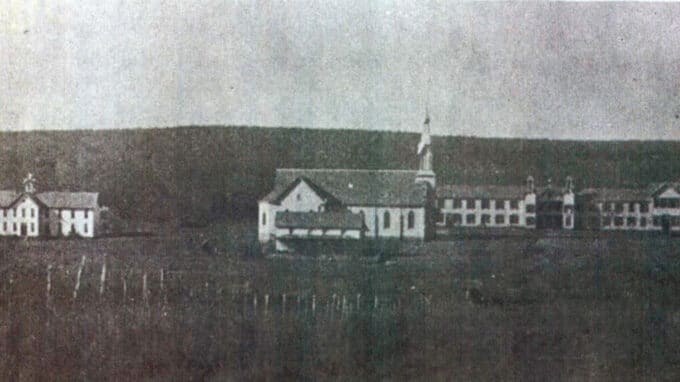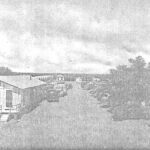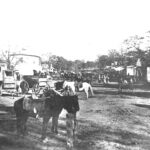From bustling pioneer settlements to oil booms and busts and growing metropolitan areas, the state of Oklahoma has undergone many changes since the Potawatomi arrived in Indian Territory in 1872. That includes the demise of many small, rural communities. Although numerous towns once existed throughout Citizen Potawatomi Nation’s jurisdiction, a few stand out, including Adell, Burnett, Econtuchka, Isabella/Clardyville, Pleasant Prairie, Sacred Heart and Pearson/Pearson Switch.
In the 19th and 20th centuries, municipalities existed within a short distance from each other due to the lack of modern transportation. While a journey of 10 to 20 miles today can occur in less than 30 minutes, in the late 1800s, that was simply not the case.
“It was truly just for a function of daily life. It was easier to have these smaller, scattered communities so that people could go about their daily business of farming or doing whatever they needed to do,” said Dr. Kelli Mosteller, Citizen Potawatomi Nation’s Cultural Heritage Center director.
The arrival of railways increased transportation and travel, which impacted whether or not communities thrived or dwindled.
“Before the railroads came, (towns) popped up around people’s allotments and settlements and roads that had been made for horses and carts. After that, it was almost all based around the path of the railroad because that’s what drove industry,” she explained.
The land runs in the 1880s and 1890s also impacted settlements as hopeful landowners staked their claims to property near suspected railways and other places of opportunity.
“The land runs really determined what was considered valuable, and there was a new calculation in that,” Dr. Mosteller said. “It wasn’t just a question of whether it is arable farmland or is it close to a source of water? It was also how close it is to some of these existing towns, and how close is it to the path of where existing and future railroads are going to go?”
Some municipalities quickly grew around families and their need for a school and access to supplies. However, the rapid changes across Indian Territory caused many to disappear almost as fast as they began.
Adell
Once located 2 miles east and 1/5 mile south of the Old Seminole Agency in present-day central Pottawatomie County, the town of Adell received its name after the daughter of Amable and Mary Margaret Toupin, Adell Toupin Bowles. The Toupin family are known as one of the founding families for the Citizen Potawatomi Nation.
Amable received an allotment just south of the current Citizen Potawatomi Nation’s complex, and Mary Margaret chose hers in the middle of the reservation, next to the town’s center.
“You see this a lot, towns named after women, and a lot of times it’s because it was the Potawatomi woman who was the actual land holder. Her non-Native husband would have access to that land because of his wife’s status,” Dr. Mosteller said.
Adell Toupin Bowles also served as the community’s first postmaster.
“This is something that you see throughout the county, and the history of a good number of these towns is the first postmaster was a woman,” she said. “That is because the position of a postmaster, much like a teacher or a nurse, was seen as one that was respectable for a young woman.”
Records indicate Amable supported his daughter’s role as postmaster, and although he owned his own property elsewhere, he chose to settle and live on his wife’s land.
“Why Mary Margaret chose hers in the center of the county is likely that being in a central location is a good bet. … If you scatter your land out a little bit, and the tide changes and the circumstances change … you protected yourself a little bit from those vulnerabilities,” Dr. Mosteller said.
Although Adell ceased to exist around 1898, the Toupin family remains alive and strong within the CPN.
Burnett
Named after descendants of Potawatomi Chief Abram Burnett, the town of Burnett was located 4 miles west and 1 mile north of present-day Macomb, Oklahoma. Although Chief Burnett remained in Kansas where the family established successful businesses, many of his descendants moved to Indian Territory to expand their enterprises.
“That’s one thing you have to consider is when you move from one reservation to the next, your family connections are not severed,” Dr. Mosteller said. “When the Burnett family moved down … the markets were expanding for their trade goods and horses and all of the things that had made them fairly well-off in Kansas. The conditions were very similar.”
At one point in the town’s history, it was the largest community in County B, which eventually became Pottawatomie County.
“It had saloons; it had hotels; it had a mill,” she said. “Some of these towns existed for three months then dissolved, but Burnett was an actual town with a really great trade base.”
However, the railroad’s establishment through Tecumseh caused the population to shift.
“Burnett gave them a run for their money for a few years before settlement patterns changed, and it slowly died out,” Dr. Mosteller said.
The town dissolved in 1907, but its legacy continues
“Making the most of it in very challenging circumstances has been something that makes them a prominent family in the Tribe and carries them through today,” she said.
Econtuchka
While many Indian Territory communities were quiet, sleepy towns, Econtuchka held a reputation as a haven for outlaws. Econtuchka is Seminole word that means “the line,” named for its location along the Potawatomi and Seminole reservational boundaries in the northeast corner of what is now Pottawatomie County.
“When you’re close to borders like that, there is oftentimes a question of jurisdiction, and it becomes a grey area because people don’t know which authority has judicial control over that space,” Dr. Mosteller said.
Several Potawatomi families took allotments nearby through the Dawes Act of 1887, including some Bertrands and Bazhaws, due to its proximity to the North Canadian River.
“It was a strategic location to choose, especially when there were still a lot of questions about where the Oklahoma Capitol was going to go — where the real centers of power were going to be and where the railroads would continue to extend back into Seminole, Creek and Cherokee territories,” she said.
By the end of 1907, the town dissolved as residents began moving closer to Shawnee to be near businesses, schools, churches and more.
Isabella/Oberlin/Clardyville/Wagoza
Early in Indian Territory and Oklahoma’s beginnings, it was not uncommon for a town to change its name based upon its leadership at the time, as was the case for Isabella/Oberlin/Clardyville/Wagoza. The town, located approximately 5 miles west of Asher, began as Isabella on Feb. 15, 1875. Ten days later, it became Clardyville.
“This is one of those towns that if … you had a time-lapse map of the county, this one would be changing fairly rapidly, and it would actually be changing location as well,” Dr. Mosteller said.
Joshua Clardy, a Citizen Potawatomi, established a general store. The town was first named after his wife and local postmaster Isabella before its change.
“It was primarily his family, and a few others, who settled around him,” she said. “As people started moving closer to other resources, the town actually moved a few miles.”
Sadly, Clardy experienced the negative aspects of living in the “Wild West” firsthand when he was violently attacked at his store.
“He just sort of threw his hands up and said, ‘This is not really worth all of what we’re going through,’” Dr. Mosteller said.
He returned to Kansas where he became involved in the newspaper industry.
“He was really successful,” she said. “He actually was owner or part-owner and had a key role in several newspapers in Kansas into the 1880s and 1890s.”
Although Joshua and Isabella’s children remained in Oklahoma, the town’s named changed to Oberlin, and Mary Trousdale served as the new postmaster. It moved once more on July 18, 1881, to where the community of Pleasant Prairie once thrived. At this time, it changed to Wagoza.
By June of 1884, little remained of the migratory town.
Sacred Heart
The Potawatomi tribe granted the Catholic Order of St. Benedict 1-square-mile of its new reservation in Indian Territory to establish a church and educational facilities. Began by Father Dom Isidor Robot in 1876, the Sacred Heart Mission came to fruition with the help of nearby Potawatomi families.
“Sacred Heart is actually integral to the history of the Catholic Church west of the Mississippi,” Dr. Mosteller said. “It served almost as the archdiocese of the church in Indian Territory for a while because it was the first, large established mission, and it had a lot of reach.”
Throughout the 18th and 19th centuries, many Potawatomi converted to Catholicism, and before the land runs and statehood, Tribal members served as one of the largest numbers of Catholics within the territory.
The church established a girls’ school in the 1880s before completing the boys’ facilities shortly after.
“If you were going to send your child somewhere to get that ‘Western education’ and you lived in Pottawatomie County, this was the most natural choice,” Dr. Mosteller said.
Sacred Heart inspired Citizen Potawatomi tribal member Albert Negahnquet to become the first full-blooded Native American Catholic ordained priest.
“He really learned at the knee of a lot of the fathers who taught at Sacred Heart and helped get that mission established,” she said. “He then went to seminary in Rome, and he came back and taught amongst his people.”
Rather than receiving his education to minister to other communities, Albert, ordained Father Dom Bede, wished to teach the gospel in his Native language to fellow Citizen Potawatomi members.
“That was something that was very important to him,” Dr. Mosteller said.
The Catholic Church’s impact on the Nation, and Sacred Heart in particular, can bring about varied emotions and memories for Citizen Potawatomi families today. Some see the mission and other religious influences as an integral part of assimilation efforts, viewing the church and its work as a negative aspect of the Nation’s history.
“It is perceived differently depending on people’s understanding of it — people’s experiences with it. … But we can’t discount that Sacred Heart and the lived experiences of our ancestors are critical pieces of our history as Native people but our history as the first people to really set up and establish what is today Pottawatomie County,” she said.
In 1901, tragedy struck Sacred Heart when a fire damaged and destroyed numerous buildings. Instead of rebuilding, the school moved to a new location further north that later became St. Gregory’s University. However, the Mission Church at Sacred Heart remains an active perish today.
Pearson/Pearson Switch
Albert Negahnquet’s father Steven Neghanquet received an allotment near the town of Pearson, later named Pearson Switch. Many other Potawatomi also called the area home.
“It was referred to as Pearson Switch because the Rock Island Railroad, as it came south out of Shawneetown, came to a split and had a side spur that went farther west in to the county,” Dr. Mosteller said.
The railroad strategically placed additional lines to capture more rural, remote areas. It increased the ability to deliver goods and conduct trade.
Although it mostly comprised of the Neghanquet’s land, a settler with the name of Pearson established a store.
“A lot of these towns are named after a person who either owns the land or the person who had the biggest business,” she said.
According to Dr. Mosteller, this area of the county may not have grown and flourished without the Rock Island Railroad creating a spur. However, even the railroad could not prevent the town from dissolving.
“Having one element that draws people to your town is often not enough to keep them when all these other towns are starting to grow more quickly,” she added.
Pleasant Prairie
After signing the Treaty of 1867, Citizen Potawatomi began making their way south from Kansas, moving to a community named Pleasant Prairie in the southern portion of the new reservation in Indian Territory.
“It was temporary. They were settling here to just get their feet under them,” Dr. Mosteller explained.
When Tribal members had to select allotments in the years that followed, many of the families moved elsewhere across the reservation. Eventually, Wanette absorbed Pleasant Prairie. However, the Nation remembers its impact.
“It was sort of the first home base. It was where those Potawatomi families came down and saw this was going to be their future and resolved to make the best of it and to turn this into our new homeland as best we could,” she said.
Although little remains of these once lively towns, their impact on Pottawatomie County — and Citizen Potawatomi — history remains today.
“I think it’s really important for us to remember these — we call them ghost towns — but the families that helped to found them are still here. Their descendants are still around. … I think recognizing the initiative that it took to strike out in someplace new and try to make a go of it in a way, it really shows the efforts and the heart (of) our early Potawatomi families who settled around here and the county. And it’s something to be not only remembered but respected and honored,” Dr. Mosteller said.
Learn more about these towns and the Potawatomi families that helped establish them by visiting potawatomiheritage.com or touring the Cultural Heritage Center.




